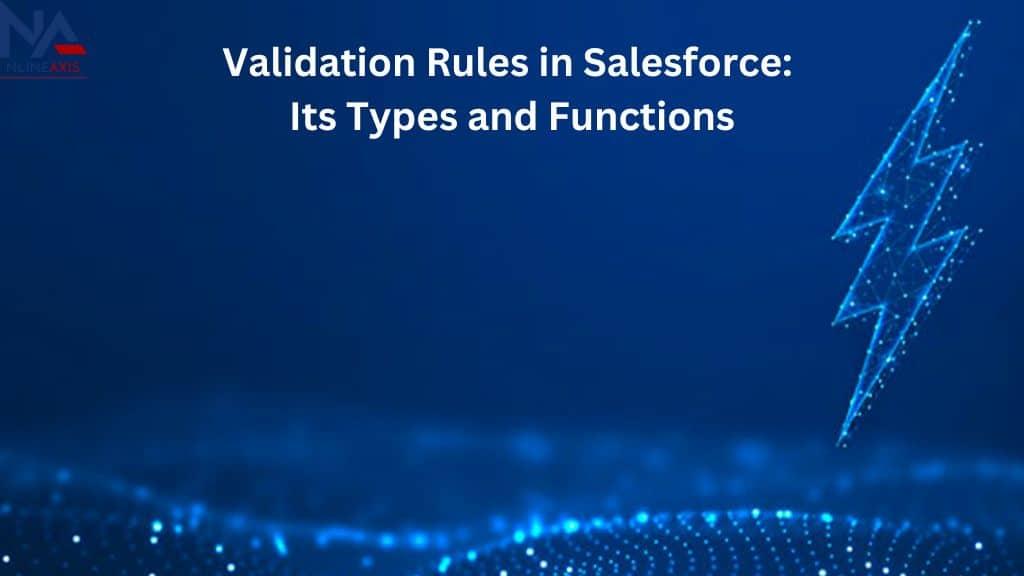Validation Rules in Salesforce: Its Types and Functions
It may be challenging to trace the eminence of the input data given the regular updates employees make to Salesforce databases. Using Validation Rules, Salesforce provides a way to define verification parameters, standardize the data requirements generally, and protect users from errors (for example showing phone numbers in the wrong format). This article explores the realm of validation rules in Salesforce, delving into their types, functions, and importance within the setting of several business processes.
NLINEAXIS IT Solutions Private Limited stands as a beacon of excellence when it comes to harnessing the power of validation rules within the Salesforce ecosystem. With a proven track record of delivering cutting-edge solutions, NLINEAXIS IT Solutions offers a comprehensive suite of services that revolve around the implementation, optimization, and management of validation rules in Salesforce.
What Is Validation Rules in Salesforce?
Salesforce Validation Rules validate the data that a user registers while altering or creating a record. It helps to ensure that data should satisfy the expectations stated by the business and the user. It can comprise a formula-based expression that assesses the data in single or more arenas and every time yields a value of true or false. This article explores the realm of validation rules in Salesforce, delving into their types, functions, and importance within the setting of several business processes.
Validation Rules in salesforce also contain an error message to show to the user when the rule yields a value true because of an invalid value/data.
Below mentioned are two cases:
Case 1: Should the condition hold true, the error message will be displayed upon attempting to save the record, and consequently, the record will not be stored in the database.
Case 2: If the condition is false, there will not be any occurrence of an error during the record-saving process, and the record will be successfully stored in the database.
Types of Validation Rules In Salesforce
Validation rules play a significant role in maintaining data precision and uniformity within Salesforce. Various types of validation rules exist to guarantee the legitimacy and alignment of entered data with specific criteria. Below are some of the types of validation rules:
- Data Type Check: A data type check makes sure that the data recorded into a field is of the right type.
- Code Check: A code check makes sure that the data registered into a field fulfils specific conditions based on a definite code.
- Range Check: A range check makes sure that the data registered into a field takes place in the precise range.
- Format Check: A format check makes sure that the data registered into a field is like the given format, for example a phone number or an email address.
- Consistency Check: A consistency check makes sure that the data registered into several fields is compatible with one another.
- Uniqueness Check: A uniqueness check makes sure that the data registered into a field is exclusive within a particular context, for example within a particular record type or object.
- Presence Check: A presence check makes sure that a field is not left empty.
- Length Check: A length check makes sure that the data registered into a field fulfils specific length expectations.
- Look Up: A look-up validation rule makes sure that a value registered in one field is similar to the value in different field in an associated object.
Also Check: Top Salesforce Chrome Extensions in 2023
Function of Validation Rules
Validation rules play a vital role in safeguarding the precision and uniformity of data within the Salesforce platform. Let’s delve deeper into the specific roles and functions of each type of validation rule:
- Data Type Check: To ensure data integrity and consistency, a data type check is performed to make sure whether the provided input aligns with the prescribed data type for a particular field. This precautionary measure is important to prevent errors and uphold uniformity in data storage.
- Code Check: A code check mechanism is employed to verify whether the data inputted into a field adheres to predefined criteria established by a specific code. This serves the purpose of confirming that the entered data falls within designated parameters or fulfils predetermined conditions.
- Range Check: A range check is employed to verify whether the input data within a field stays within the allowable boundaries. This validation is vital to guarantee that the registered data remains within permissible thresholds. For instance, a range check can ascertain that a discount registered into a field stays within the confines of 0% to 50%.
- Format Check: A format check is utilized to confirm whether the data inputted into a field conforms to a predetermined format, such as that of a phone number or an email address. This validation serves the purpose of assuring that data is constantly inputted in a standardized format.
- Consistency Check: A consistency check is executed to confirm whether the data entered across multiple fields maintains coherence. This validation holds significance in ensuring that the information inputted in diverse fields remains interconnected and valid.
- Uniqueness Check: To ensure exclusivity within a designated context, such as a record type or object, a uniqueness check is taken on. This validation guarantees that the entered data remains distinct and evades duplication within other fields or records.
- Presence Check: To ensure that a field is not devoid of data, use a presence check. Through this approach, you can make sure that all requisite fields contain data and that it is accurate.
- Length Check: In order to ensure compliance with predetermined length standards for a field, a length check is used. This approach makes sure that the data entered a field neither surpasses nor falls short of the specified length limits.
- Look Up: Look up validation rule is applied to confirm whether the input value within a specific field aligns with the value existing in another field belonging to a connected object. This validation assurances the connection of data entered in one field with the data existing in another field or object.
While validation rules in salesforce are vital for data quality, there are situations where their implementation needs to be momentarily dominated to accommodate business needs. This is where the concept of bypassing validation rules in flow Salesforce comes into play. Bypassing validation rules in a flow salesforce includes the use of a setting referred to as “Bypass Validation Rules”. When this setting is allowed, the flow can adapt or create records without following to the typical validation rules. This can be specifically useful when you have circumstances where data entered through a flow might not instantly fulfil the validation criteria but will be updated later to meet those standards.
In the field of Salesforce development, businesses frequently need skill to implement validation rules and other complicated functionalities efficiently. This is where the role of a Salesforce development company comes into play. Such businesses hold the information and skill to design, manage and implement complicated Salesforce solutions, confirming that businesses harness the full potential of the platform.
Furthermore, when companies try to find direction and strategic visions linked to Salesforce application and optimization, Salesforce consulting companies provide vital assistance. These consultancies provide knowledge in tailoring Salesforce solutions to match the exceptional requirements of organisations, increasing efficiency and promoting growth.
NLINEAXIS IT Solutions recognizes that bypassing validation rules in Salesforce flows can be a delicate task that requires finesse. The company’s experts understand the delicate balance between adhering to data quality standards and accommodating specific business requirements. They employ their deep understanding of Salesforce flows to ensure that validation rules are bypassed judiciously, without compromising the overall data integrity.


